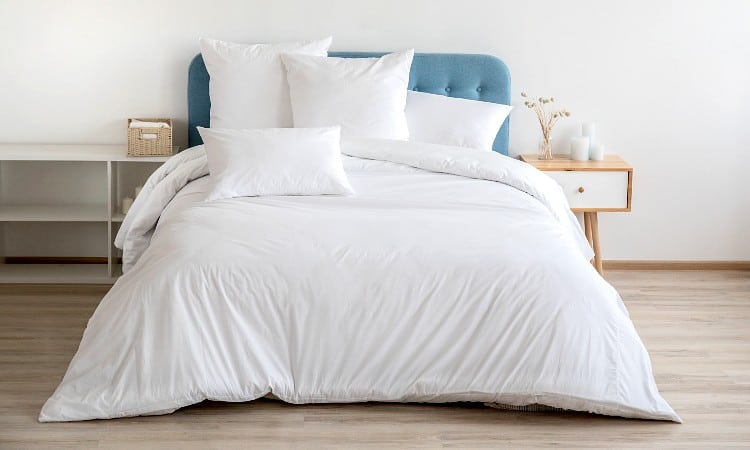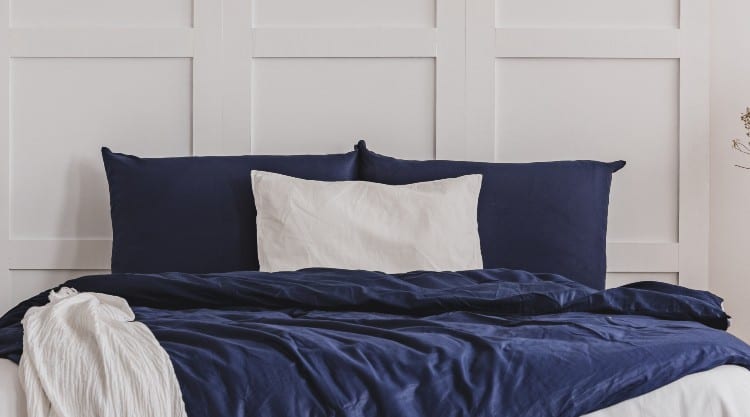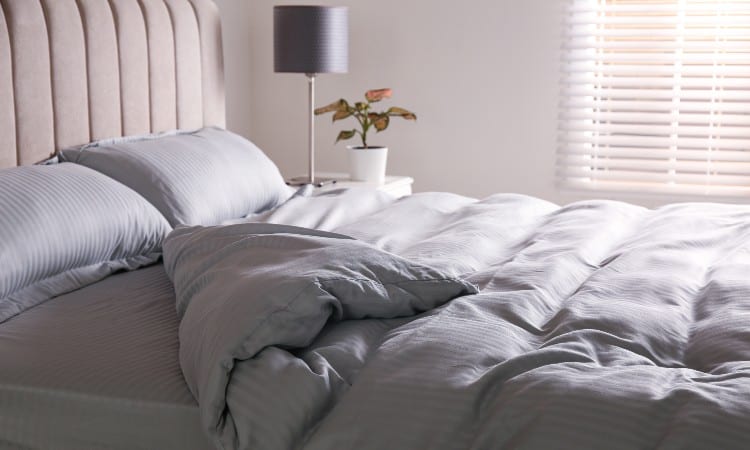Duvet covers make washing and changing up your bedding a lot easier. They can be easily removed from the duvet itself if they need to be washed while providing just as much style and comfort as other types of bedding. But duvet covers can be expensive, so if you want to make your own, you may be wondering what’s the best fabric to use.
The best fabric for a duvet cover should be lightweight and breathable but also keep you feeling cozy and comfortable. Some great fabrics to use include:
- Cotton
- Percale Cotton
- Linen
- Cotton/Polyester Blend
- Silk
- Flannel
Although these fabrics are good choices, some aren’t for everyone. In this article, I’ll explain more about these fabrics and why they are good for duvet covers. I’ll also explain what to avoid and how to choose the right fabric for you. Once you decide, I’ll explain how much fabric you need to make a duvet cover.

Quick Navigation
- What Is the Best Fabric for Duvet Cover?
- What Is the Most Breathable Fabric for a Duvet Cover?
- What Is the Most Durable Fabric for a Duvet Cover?
- What Fabrics Should You Avoid for Duvet Covers?
- How to Choose Fabric for a Duvet Cover
- How Much Fabric for Duvet Cover?
- Duvet Cover Fabric by the Yard
- Conclusion
What Is the Best Fabric for Duvet Cover?
There is no one true best fabric for a duvet cover. Rather, there are several good fabrics you can use, each with its pros and cons. The best one for you depends on your lifestyle and what kind of sleeper you are. Let’s look at some good fabrics to use for duvet covers, along with the characteristics of each one.
1. Cotton
 Cotton is one of the best fabrics for any purpose, and duvet covers are no exception. It’s affordable, very breathable, and lightweight while also being easy to clean. If you want your duvet cover to be extra soft and cozy, opt for higher-quality cotton varieties such as Pima, Supima, or Egyptian cotton.
Cotton is one of the best fabrics for any purpose, and duvet covers are no exception. It’s affordable, very breathable, and lightweight while also being easy to clean. If you want your duvet cover to be extra soft and cozy, opt for higher-quality cotton varieties such as Pima, Supima, or Egyptian cotton.
Pima, Supima, and Egyptian cotton are all long-staple cotton, meaning the individual fibers are longer than typical cotton. That means that they are softer and a bit stronger as well. Duvet covers made from these types of cotton will be more durable, especially Supima cotton. They also have higher thread counts, making them so soft. The downside is that long staple cottons tend to be more expensive.
2. Percale Cotton
 Another type of cotton fabric that is great for duvet covers is percale cotton. Percale cotton is the fabric that is often used for hotel sheets and bedding. It’s lightweight and one of the most breathable fabrics on this list. But, it does have a lower thread count, which means that although it is soft, it may not be as soft as other types of cotton.
Another type of cotton fabric that is great for duvet covers is percale cotton. Percale cotton is the fabric that is often used for hotel sheets and bedding. It’s lightweight and one of the most breathable fabrics on this list. But, it does have a lower thread count, which means that although it is soft, it may not be as soft as other types of cotton.
However, the threads in percale cotton are tightly woven, which makes it incredibly durable. Duvet covers made from percale cotton will generally last a very long time. This type of fabric is also easy to wash and keep clean. You just may not have as many fabric varieties to choose from.
3. Linen
 Linen is another lightweight and airy fabric that’s widely used for bedding. If you tend to get hot while you sleep, linen is definitely a fabric you want to consider. It’s very breathable and can help to keep you cool at night. Linen is also soft.
Linen is another lightweight and airy fabric that’s widely used for bedding. If you tend to get hot while you sleep, linen is definitely a fabric you want to consider. It’s very breathable and can help to keep you cool at night. Linen is also soft.
It can be durable with the right care, but it can wrinkle easily. You also have to be careful with washing it because it can shrink. You may wish to use it in a guest room where it won’t get as much use and wear and tear. There isn’t as much availability of linen fabrics as there is with cotton. But if you want a light and airy look to your decor, then linen fits the bill perfectly.
4. Cotton/Polyester Blend
 If you’re looking for the most affordable option for fabric for a duvet cover, then a cotton/polyester blend fabric is a good choice. These fabrics are also readily available and easy to find. There is typically a wide range of colors and patterns to choose from.
If you’re looking for the most affordable option for fabric for a duvet cover, then a cotton/polyester blend fabric is a good choice. These fabrics are also readily available and easy to find. There is typically a wide range of colors and patterns to choose from.
Cotton/poly blends are also durable and easy to clean, making them a great option for duvet covers if you have kids and pets. They also don’t wrinkle easily. The downside to using a cotton/poly blend for a duvet cover is that it isn’t be quite as breathable as cotton or linen. It may also not be as soft or comfy. All those factors depend on how much cotton vs. polyester the fabric is made of.
5. Silk
 If you want the most luxurious fabric for your duvet cover, go with silk. It has an elegant, smooth, and shiny texture that is very cool to the touch. Silk is also very breathable, so it’s another great choice for people that get hot when they sleep.
If you want the most luxurious fabric for your duvet cover, go with silk. It has an elegant, smooth, and shiny texture that is very cool to the touch. Silk is also very breathable, so it’s another great choice for people that get hot when they sleep.
However, silk is also the most expensive fabric on this list. You can buy cheaper versions made from polyester instead of true silk, but they won’t give you the same breathability. Silk is also considered a delicate fabric that is hard to wash and maintain. You don’t want to use this fabric with kids and pets, especially if you purchase the expensive fabric.
6. Flannel
 Flannel is one of the softest materials and the warmest on our list. It’s generally made of brushed cotton to give it a unique and fuzzy texture. Flannel is also very easy to clean and it is durable and lightweight.
Flannel is one of the softest materials and the warmest on our list. It’s generally made of brushed cotton to give it a unique and fuzzy texture. Flannel is also very easy to clean and it is durable and lightweight.
If you live in a colder climate, flannel is a great option for a duvet cover. It’s also a good choice during the winter. But, you don’t want to use it if you already get hot when you sleep. Flannel will not help with that problem and can only make it worse. It can also be too hot in warmer months even if you don’t get hot when you sleep.
What Is the Most Breathable Fabric for a Duvet Cover?

If you are someone that gets hot when you sleep, or the thought of sleeping under covers makes you feel stuffy, then you want a fabric that will be breathable for your duvet cover.
The most breathable fabrics for duvet covers are linen, percale cotton, and silk.
Each of these fabrics has its pros and cons unrelated to breathability, but all are great if you don’t want to feel hot when you sleep. When deciding between them, you’ll want to consider other characteristics such as durability and how easy they are to clean. Even though flannel is breathable, it also has a natural tendency to trap warm air, so you don’t want to use it if you need something airy.
What Is the Most Durable Fabric for a Duvet Cover?
If you have kids and pets or just toss and turn a lot in your sleep, you will want a durable fabric. The most durable fabric for a duvet cover will be a cotton/polyester blend. Flannel is also pretty durable, but neither of these fabrics is the most breathable. If you need something that is both durable and breathable, you may choose to go with cotton or percale cotton. Supima cotton is also a good choice but is more expensive than other fabrics.
What Fabrics Should You Avoid for Duvet Covers?
When choosing fabric for a duvet cover, you want to avoid anything too heavy or considered to be a heavyweight fabric. That means that you want to avoid any fabric that is typically used for upholstery. Avoid fabrics such as brocade and jacquard, which tend to be heavier. These fabrics also aren’t very breathable either.
Duvets are intended to be lighter than comforters, so if you choose to have a duvet instead of a comforter, heavy fabrics will only weigh it down. You’ll want to stick with lightweight fabrics that aren’t as suffocating and are more breathable. Another benefit of duvets and duvet covers is that they are easier to care for since they aren’t as heavy as comforters. So choosing a lightweight fabric helps maintain that ease of care.
How to Choose Fabric for a Duvet Cover

Now that you know the different fabrics that are good for duvet covers, how can you choose which is best for you? Here are some tips to help you decide.
Choose Material Carefully
I’ve mentioned this already, but you want to make sure you choose your material carefully. Consider your sleeping habits when deciding which fabric to choose. If you get hot when you sleep, choose a lightweight and breathable fabric. If you tend to get cold, choose a warmer fabric. Also, if you move around a lot in your sleep, choose something durable to withstand tossing and turning.
Appearance
You’ll also want to consider the decor in your room and choose a fabric that fits it. Different fabrics come in different colors and patterns. You’ll have a much larger selection of fabrics, such as cotton and cotton/polyester blends. But, fabrics such as linen, percale, and flannel may have fewer choices.
Ease of Care
Next, consider how easy the fabric is to care for. The great thing is that duvet covers are designed to be removed from the duvet and washed easily. So, you want to choose a fabric that can be washed easily, especially if you have kids and pets. At the very least, you want the fabric to be easy to spot clean. Cotton, cotton/poly blends, and flannel are easy to clean and care for, but silk and linen are a bit more difficult.
Cost
Another important factor to consider is your budget. Remember that you’re going to need to buy multiple yards of fabric. Choose a fabric that you can reasonably afford, not necessarily the nicest fabric out there. As long as the fabric has all the characteristics you want, you don’t have to pay a premium price.
Don’t Forget Embellishments
Duvet covers are designed to be slipped over a duvet and secured so they don’t come off easily. That means you’re going to need a way to secure it. Common ways to secure duvet covers include buttons, ties, or zippers. Make sure you buy the supplies needed to secure it when you purchase the fabric. If you want other embellishments, such as ribbons, make sure you pick them up.
How Much Fabric for Duvet Cover?
If you make your own duvet cover, you’ll need to know how much fabric you need. It just depends on the size of the bed. Here’s a chart that gives common duvet sizes and how much fabric you need.
| Mattress Size | Duvet Size | Amount of Fabric Needed per side) |
| Twin (39” x 75”) | 69” x 90” | 6 yards |
| Full (54” x 75”) | 86” x 90” | 6 yards |
| Queen (60” x 80”) | 90” x 96” | 6 yards |
| King (78” x 80”) | 108” x 96” | 6 yards |
Note that for a twin bed, you may have more fabric left over, but 6 yards ensures you have plenty and can adjust the length of the sides if necessary. Otherwise, 6 yards should be plenty for full, queen, and king-size duvet covers. Note also that 6 yards is the amount of fabric needed for one side of the cover. You’ll need to double that amount for both sides.
Duvet Cover Fabric by the Yard
You should be able to find fabric for a duvet cover in any place where fabrics are sold. However, the fabric selection varies based on the store and the type of fabric you want. The cost will also vary based on the store and the type of fabric. In general, you can find cotton/polyester blend fabric for as little as $2-3 per yard.
But, just to give you an idea of the price differences between the lowest and the highest, silk fabric can cost as much as $10-15 per yard or more. Fabric for duvet covers usually comes in widths of 42 to 60 inches, depending on the type of fabric that you buy.
Conclusion
Many fabrics can be used for a duvet cover. But, the best fabrics should be soft, lightweight, and breathable. You also want them to be durable and easy to clean and care for. Keep your sleeping habits in mind when choosing fabric for your duvet cover. If you found this article helpful, share it with others.